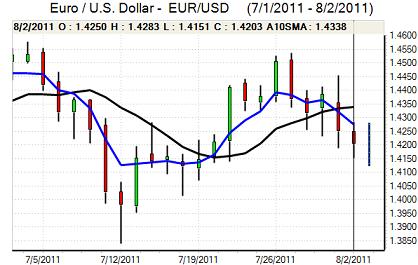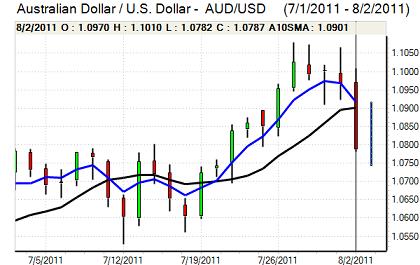EUR/USD
Volatility increased sharply during Monday as fear dominated the markets. The Euro weakened sharply to lows below 1.4150 against the dollar before rebounded to 1.4280 and then weakening again late in the US session. Risk appetite was extremely fragile which provided some net US support against the Euro. The Libor-OIS spread increased to a two-year high which illustrated the increase in market fears.
There was a further increase in Euro-zone tensions during the day with a sharp widening in peripheral yield spreads with a particular focus on Spain and Italy. Italian yields rose to 14-year highs during the session while Spanish yields also rose sharply. Italian officials are due to hold emergency meetings during Wednesday while Spanish Prime Minister Zapatero also stated that holiday plans would be postponed to monitor the economic situation.
There was further speculation that an expansion of the EFSF would be required, but this would run into heavy political opposition and markets doubted the commitment for a near-term increase, especially from Germany. There was also speculation that the ECB would be forced to intervene and buy peripheral bonds in the open market with Thursday’s council meeting an important focus.
The US Senate comfortably approved the US debt-ceiling legislation and Obama’s signing of the bill formally removed any default threat. Moody’s affirmed its AAA credit rating for the US while Fitch stated that the situation was still under review. There was no announcement from Standard & Poor’s.
The US economic data was again weaker than expected with a dip in personal spending for the first time in two years which maintained expectations of a deterioration in conditions. The services-sector PMI data will be watched very closely on Wednesday for further evidence on the economy.

Source: VantagePoint Intermarket Analysis Software
Call now and you will be provided with FREE recent forecasts
that are up to 86% accurate * 800-732-5407
If you would rather have the recent forecasts sent to you, please go here
Yen
The dollar found support just below 77 against the yen during Tuesday, but was unable to make significant headway. Both currencies derived some degree of defensive support which curbed movement between the pair. The Euro found some support above 109 against the Japanese currency
The yen continued to gain support from a deterioration in international risk appetite and fears over a downturn in the global economy. There were further warnings from the Finance Ministry over the potential for intervention with warnings that markets were being watched very closely, but there was still no sign of official action.
There was additional speculation that there would be intervention to weaken the Japanese currency, potentially in tandem with a further Bank of Japan easing of monetary policy at the policy meeting on Friday.
Sterling
Sterling hit resistance above 1.63 against the dollar during Tuesday and weakened to lows near 1.6220 before regaining ground in very choppy trading conditions.
The construction PMI index was slightly stronger than expected with a small decline to 53.5 for July from 53.6 previously which provided some relief while the BRC shop-price index edged slightly lower to 2.8% from 2.9% previously.
The services-sector index will be watched very closely on Wednesday and a weak reading would increase pressure for further quantitative easing by the Bank of England. The banking sector will also be watched closely and there were concerns that renewed liquidity stresses would further damage lending prospects which would also undermine growth.
The UK currency still gained some support as a refuge from Euro-zone woes and pushed to a two-month high near 0.87 against the Euro.
Swiss franc
The Euro hit resistance close to 1.1150 against the franc on Tuesday and was subjected to further very strong selling pressure during the day with rapid declines to fresh record lows near 1.08 before a limited recovery. The dollar also failed to make any impression on the franc and weakened to new record lows near 0.76 before a tentative recovery.
Safe-haven demand continued to dominate market action during the day with increased fears over the Euro-zone and global economies triggering fresh demand for the Swiss currency. Domestic fears over the competitive situation have increased and there will be fresh pressure on the National Bank to take decisive action and intervene aggressively.

Source: VantagePoint Intermarket Analysis Software
Call now and you will be provided with FREE recent forecasts
that are up to 86% accurate * 800-732-5407
If you would rather have the recent forecasts sent to you, please go here
Australian dollar
The Australian dollar was unable to regain the 1.0920 level against the US currency during Tuesday and was subjected to further intense selling pressure during the day with a retreat to lows below 1.07 in local trading on Wednesday before a partial recovery.
The currency was undermined by a severe deterioration in risk appetite as fear increased and equity markets came under heavy selling pressure. Domestically, the retail sales report was weaker than expected with a 0.1% decline for June while the PMI services-sector index remained below the 50 level despite a small monthly improvement.



